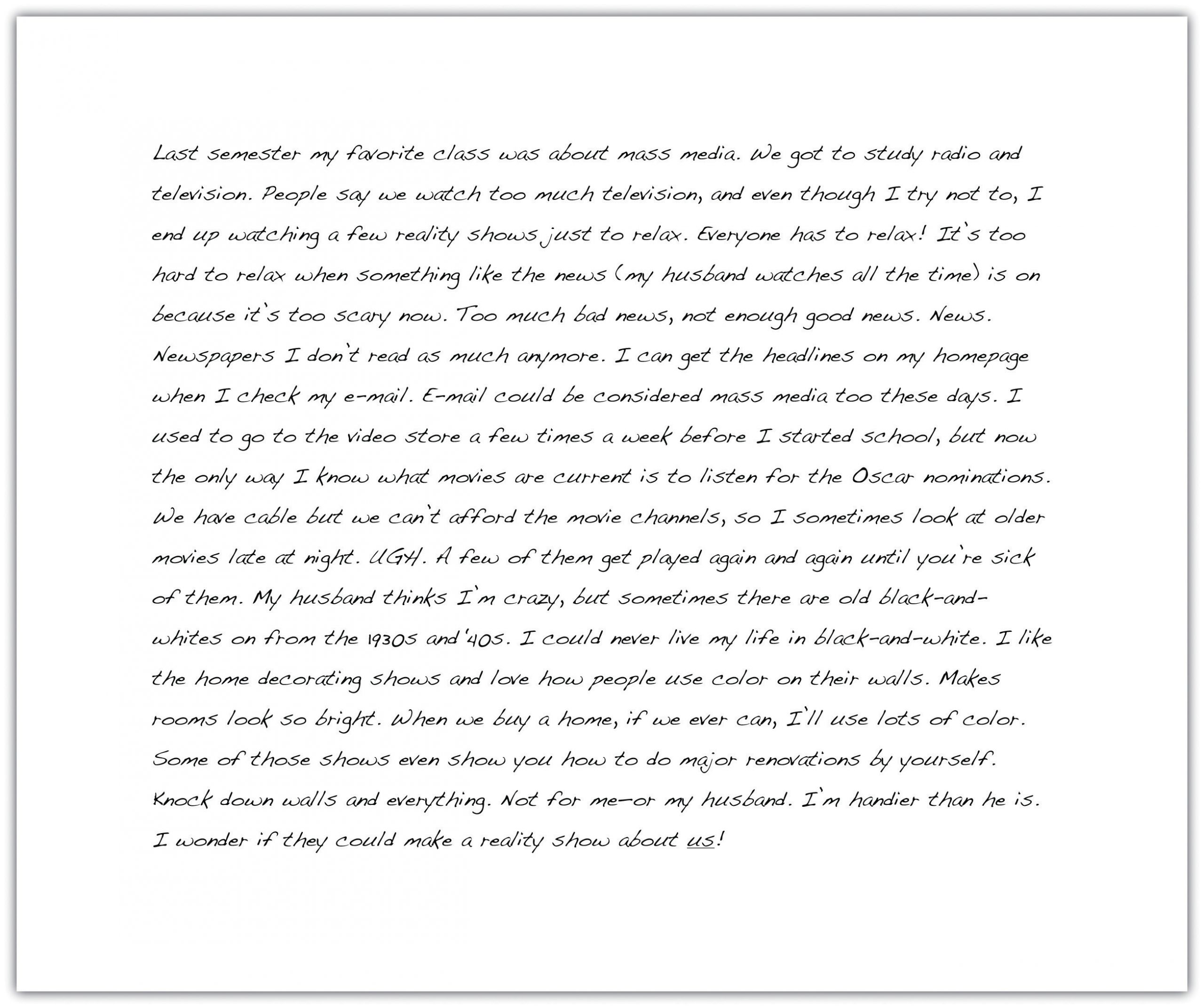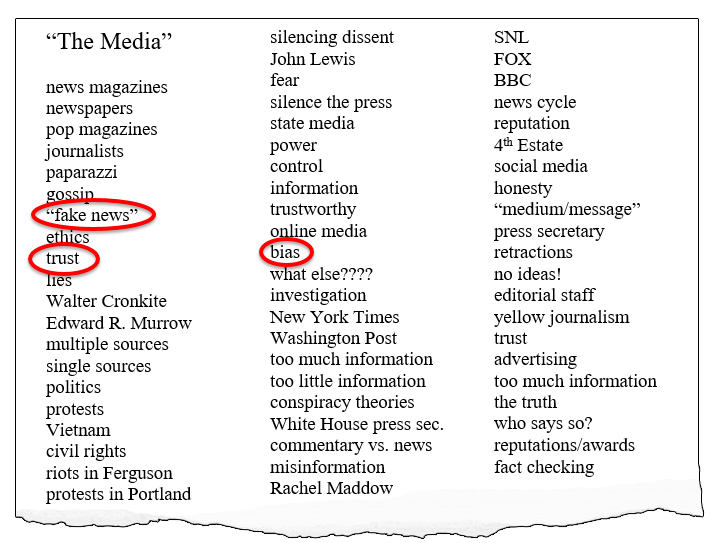6.1 Getting Started
Preview
This section of Ch. 6 will introduce the following topics:
- using a writing process
- the purpose of prewriting
- four types of prewriting
- choosing a good topic
Effective writing is simply good ideas expressed well and arranged clearly. But effective writing is not something one just sits down and does. You can write a shopping list like that or a text, but anything you are going to submit to a reader who will evaluate your work should be planned and polished.
Good writers use a writing process. Students who want to improve their writing discover that a writing process will help them achieve that goal. (It also reduces stress and improves grades.)
The Writing Process
The writing process outlined here is not difficult. It involves five steps and it takes several sessions, but ultimately it will make writing easier, faster, and more successful for you.
Here are the five steps of the writing process:
- Prewriting: generate and begin developing ideas.
- Outlining: identify the document’s purpose and determine the thesis, basic content, and organizational structure.
- Drafting: develop the points identified in the outline, adding detail, examples, and commentary, then write an engaging introduction and a useful conclusion. After this step, the writer has a first draft.
- Revising: review and reshape the draft. This involves moderate to major changes: adding or deleting sentences or even paragraphs, expanding an important idea, replacing a vague word with a more precise one, reorganizing points. The goal is to improve the document’s quality and clarity.
- Editing: make final changes to ensure adherence to standard writing conventions, fixing errors in grammar and spelling, then formatting the document. The goal of editing is correctness.
Once these five steps have been completed, a careful writer will seek the advice of knowledgeable others before considering the document complete. In college, this advice usually takes the form of peer editing groups or tutors.
Common Misconceptions
Some students have had good experience with a writing process in the past. Some have never heard of “a writing process.” Others are doubtful that anything can help. Following are common misconceptions about the writing process:
- “I do not have to waste time on prewriting if I understand the assignment.” Even if the task is straightforward and you feel ready to start, taking time to develop ideas before you write a draft gives you an opportunity to consider what you want to say before you jump in (and then have to back up). It actually saves time overall.
- “It is important to complete a formal, numbered outline for every writing assignment.” For lengthy research papers, a formal outline can be helpful. For shorter assignments, a scratch outline like the one recommended in this process is sufficient. The important thing is to plan the document before starting to write, to know where you are going and how you want to get there.
- “My draft will be better if I write it when I am feeling inspired.” By all means, take advantage of moments of inspiration. But understand that “inspired” work is often disorganized, incomplete, and unclear. Also, in college you often have to write when you are not in the mood.
- “My instructor will tell me everything I need to revise.” It is your job, not your instructor’s, to transform a rough draft into a final, polished piece of writing.
- “I am a good writer, so I do not need to revise or edit.” Great writers all revise their work. Shakespeare, J.K. Rowling, Atul Gawande, and George R.R. Martin all revise their writing.
Planning Backward
Using a writing process requires multiple sessions of writing time. Do not try to move from Step 1 to Step 5 too fast. Trying to work fast is stressful, and it does not yield great results.
When your instructor gives you a writing assignment, write the due date on your calendar. Then work backward to set aside blocks of time when you will work on the assignment. Schedule at least six work sessions. (Step 3 often takes two sessions.) Each session should be an hour or two. Less time won’t let you get any important work done, but longer is exhausting, and exhausted writers don’t write well.
If you find you need additional time, add it in small chunks throughout the process rather than trying to do a lot of work the night before the deadline. If things go smoothly and you end up with extra time, spend it on additional revision and editing.
Step 1: Prewriting
If you think a blank sheet of paper or a blinking cursor on a blank computer screen is scary, you are not alone. Beginning to write can be intimidating. However, experienced writers remind themselves that writing is a process. Any big project can be accomplished if you take it one step at a time.
Prewriting is the first stage of the writing process. Prewriting can help you get started if you don’t know where to begin. It can help you narrow a topic that is too broad, explore what you know about your chosen topic, and find interesting details. It is brainstorming in writing.
We get our ideas from many places: what we read, what we hear, what we see and experience, our imagination. Prewriting helps us turn all of that information into words on a page. Prewriting is a way to break through writing blocks, to get ideas out of your head and down on paper so you have something with which to work.
There are a few, very simple rules for prewriting:
- Use paper and pencil or a computer, whichever allows you to write more quickly.
- Write your topic at the top of the page to remind yourself to stick to it. If you wander off, just look at your topic and wander back.
- Don’t worry about spelling, punctuation, repetition, or exact wording. Your goal is to simply get as much information on the page as you can.
- Write for ten minutes. More is unnecessary; less is not enough time to find unexpected ideas.
- Don’t stop writing once you start. Keep pushing your brain to come up with one more idea and one more idea. That is when you find interesting and even surprising stuff.
Three types of prewriting are explained here: Freewriting, Listing, and Clustering. Try them all, then use the technique that works best for your thinking process or for the specific assignment you’ve been given.
Freewriting
In Freewriting, you jot down thoughts that come to mind in rough sentences or phrases. Try not to doubt or question your ideas. Allow yourself to write freely. Don’t be self-conscious. Nobody is going to grade this. Once you start writing without limitations, you may find you have more to say than you thought. If you get stuck, look at your topic again and write some more.
Here is an example of Freewriting on the topic of the media. Notice the writer isn’t worrying about grammar, fragments, or even staying on topic. She is just writing down everything that comes to mind on her topic.
Listing
Listing is like Freewriting, but instead of writing across the page, you write in columns, top to bottom, listing topics or details, one after another, without trying to sort or organize.
Here is an example of Listing on the topic of the media. Notice the ideas bounce from one to another, then off in a different direction. That’s the point: to get as many ideas on the page as possible.
Exercise 1
In your notebook, prewrite about the broad topic of Mt. Hood Community College, using either Freewriting or Listing. Follow the directions above and write without stopping for ten minutes.
After you finish, read over what you wrote. Find a few ideas that stand out, that you have an opinion on, and that might make a good essay. Circle them.
Your goal is to take a broad topic given by your instructor and narrow it down to something you can cover thoroughly in the assigned length. Writing about the media could run 300 pages easily, but looking at the difference between “news” and “commentary” or explaining the term “fake news” would make a good essay.
Clustering
Clustering allows you to visualize related ideas. Many writers like this prewriting method because it shows how ideas connect.
To do Clustering, write your general topic in the center of a blank sheet of paper. Then brainstorm specific ideas around it and use lines or arrows to connect them. Add as many ideas and sub-ideas as you can think of. Write for ten minutes; fill the page.
Note: You can do this on a computer (like the example below) but it’s much easier on paper. On a computer, you spend too much time making little circles and choosing colors. On paper, you spend the time coming up with new ideas.
Exercise 2
In your notebook, do a Clustering prewrite on one of the topics that interested you in Exercise 1. Your goal with this prewrite is to identify lots of details about that topic.
- Put the narrowed topic in the center of the page.
- Brainstorm different sub-topics, moving in different directions. Fill up the page. Don’t hesitate to go on to two or even three pages.
- After ten minutes, read what you wrote. Circle ideas that might be usable.
If you succeeded with this prewrite, you should have a narrow topic for an essay (from Ex. 1) and lots of details to help you explain your point (from Ex. 2). If that hasn’t happened yet, repeat one of the types of prewriting above. Don’t move on to the next section of this text until you have a topic that works.
Be prepared to show your prewrites to the instructor and have her approve your chosen topic.
Prewriting can be used when you begin a project to brainstorm possible topics. It can also be used to narrow a large topic. And it can be used to come up with details on your chosen topic. If you hit a dead end on your first prewrite, go do something else for a while (math homework or the laundry), then try again, using a different type of prewriting. The goal of prewriting is to get information out of your head and onto a piece of paper where you can work with it.
Choosing a Topic
Before you decide firmly on your topic, put it through a simple test by answering these questions:
- Am I interested in this topic? Would my audience be interested?
- Do I have prior knowledge of or experience with this topic, or do I have the time to learn more about it?
- Is this topic narrow enough to dig into deeply, but large enough to provide me with ideas to explore?
- Does it meet the assignment requirements? (Go back and re-read the assignment instructions.)
Once you have completed this step, you should feel less anxious about starting an essay. With some ideas on paper, writers are often more comfortable continuing to write.
Takeaways
- The writing process helps students complete any writing assignment more successfully.
- This writing process includes five steps: prewriting, organizing, drafting, revising, and editing. Allow enough time to complete each step successfully.
- Prewriting is the transfer of ideas from abstract thoughts into words, phrases, and sentences on paper.
- Types of prewriting include Freewriting, Listing, and Clustering.




